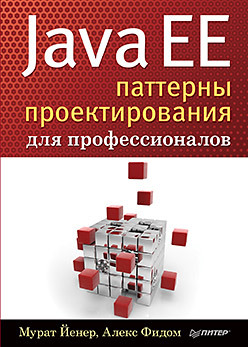The book "Java EE. Design patterns for professionals »
 We published the book of Murat Jener and Alex Fidom.
We published the book of Murat Jener and Alex Fidom.The book "Java EE. Design Patterns for Professionals ” is an indispensable resource for anyone who wants to work more effectively with Java EE, as well as the only book that discusses both the theory and practice of using design patterns with examples of real application problems.
The authors introduce the reader to both the fundamental and the most advanced features of Java EE 7, thoroughly examine each of the patterns and demonstrate how these patterns are used in solving everyday applied problems.
This edition discusses the classic design patterns, first mentioned in the famous book written by GoF1, taking into account their modernization in relation to the Java EE 6 and 7 platforms.
')
In each chapter, we describe the traditional implementation of the pattern and then show how to implement it using the Java EE platform oriented semantics.
We use complete code samples to demonstrate both the traditional implementation and the implementation for the Java EE platform, and we supplement each chapter with examples from practice that demonstrate the correct (and erroneous) use of patterns. We explore the pros and cons of each pattern and study their areas of application. At the end of each chapter are exercises to test your understanding of this pattern in Java EE.
Who is this book for?
This book is for everyone, regardless of experience level. It covers almost all of the information about patterns, starting with how they are described in other books, to simple Java implementation code, Java EE implementation and, finally, to practical examples: how and when to use a particular pattern. It also has real-life stories that discuss successful and unsuccessful patterns.
Useful knowledge of the design patterns and the Java EE platform will be helpful when reading the book. If you have already dealt with patterns and basic implementations in the Java language, you can go directly to the implementations for Java EE. However, it may be useful to refresh your memory and knowledge of design patterns.
What does this book cover?
This book covers all the classic design patterns offered by the Java EE platform as part of the standard implementation, as well as some new patterns. The coverage starts with Java EE 5 and includes the latest version of the platform currently available - Java EE 7. We hope that this publication will become a reference book that will permanently settle on your bookshelf.
How this book is structured
Each chapter is focused on one design pattern. If the pattern is classic, then after explaining its essence, a simple implementation in the Java language is given. Each chapter offers practice stories illustrating the pattern on which the chapter is focused, positive or negative real-life examples. The history from practice is followed by the implementation on the Java EE platform, an example and an explanation. Each sample code can be run separately from the others. Finally, each chapter ends with a description of where and how to effectively use this pattern.
About the authors
Murat Yener is a programming fanatic and open source software committer; currently a developer for the Android platform in the division of Intel New Devices Group. He has extensive experience developing Java applications, web frameworks, applications for the Java EE platform, and modular applications based on the OSGi specification. In addition, he is engaged in the creation of training courses and teaches. Murat is a committer of the free Eclipse development environment and one of the first committers of the Eclipse Libra project. He is currently developing native and hybrid mobile apps using the HTML5 language and the mGWT framework.
Murat has been the head of the user group for the GDC conference in Istanbul since 2009, organizing various events there, participating and speaking in them. He also speaks regularly at JavOne, EclipseCon and Devoxx conferences.
Linkedin - www.linkedin.com/in/muratyener .
Twitter - @yenerm .
Blog - www.devchronicles.com .
Alex Sidom is a leading Java developer at Indigo Code Collective indigocodecollective.com (a division of the E-scape Group) where he plays a key role in creating architectural design and developing a custom lottery and instant lottery platform.
Prior to that, he developed software for ATMs of an international Spanish bank and software for analyzing code quality for IT consulting. Alex has experience in developing Java-based web applications for a variety of industries, including finance, e-learning, lotteries, and software development. A passion for design led him to projects throughout Europe and beyond. He blogs at alextheedom.com and helps colleagues solve problems on online forums.
Linkedin - www.linkedin.com/in/alextheedom .
Twitter - @alextheedom .
Blog - www.alextheedom.com .
About the technical editor
Mohammed Sanaullah is a software developer with over five years of development experience. He is currently working for the largest Indian e-commerce enterprise, and is also a moderator at the JavaRanch forum. In his free time, he looks after his lovely little daughter. He shares his experiments and thoughts on software development at http://blog.sanaulla.info/ .
More information about the book can be found on the publisher's website.
Table of contents
Excerpt
For Habrozhiteley 25% discount coupon - Java EE .
In electronic form, the book is not for sale, upon payment of the paper book, pdf and epub of Anthony Gonsalvels ’s book “Learning Java EE 7” will come to e-mail.
Source: https://habr.com/ru/post/269141/
All Articles